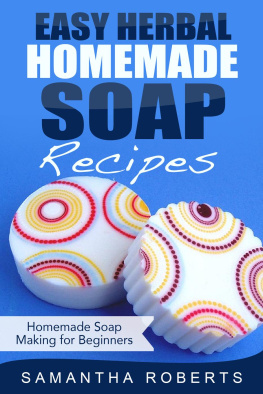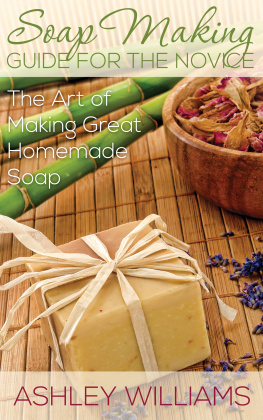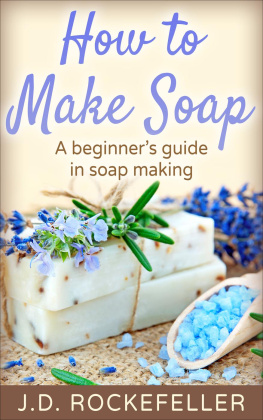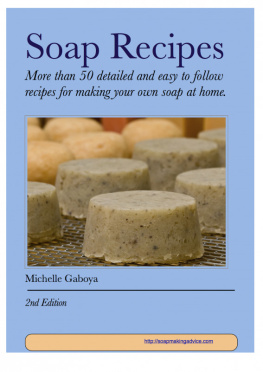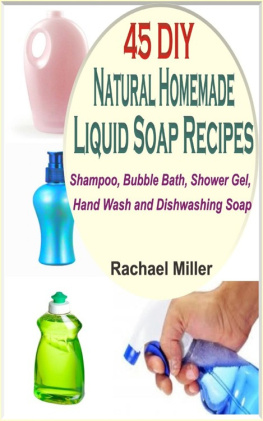Easy Herbal Homemade Soap Recipes: Homemade Soap Making for Beginners
Samantha Roberts
Published by Samantha Roberts, 2015.
While every precaution has been taken in the preparation of this book, the publisher assumes no responsibility for errors or omissions, or for damages resulting from the use of the information contained herein.
EASY HERBAL HOMEMADE SOAP RECIPES: HOMEMADE SOAP MAKING FOR BEGINNERS
First edition. July 16, 2015.
Copyright 2015 Samantha Roberts.
ISBN: 978-1513091761
Written by Samantha Roberts.
10 9 8 7 6 5 4 3 2 1
Introduction
S oaps are used in every household and not just as a cleansing agent but also something that imparts a beautiful fragrance. When people buy soaps for their fragrance, they go for synthetic and chemical based soaps that are proven to be toxic and not suitable to be used in the long run. Most of the commercially available soaps are made of chemicals and we are well aware of the harmful effects of these artificially created products.
Is there an alternative? Yes, there is. You can make wonderful smelling soaps right in your kitchen without the help of anyone else and they smell and work amazingly well. But is soap making complicated? Not at all! Soaps are extremely simple to make not only because the process is easy but because the ingredients that go into the making are easily available and are found in every household or a nearby supermarket.
In this eBook, there are several kinds of soap making recipes that you test with literally no help from anybody. These soaps can be made from the simplest of ingredients. Not only are they fragrant, they also are safe on your skin; thanks to the organic ingredients that go into making these soaps.
Using these soaps indirectly revitalizes your body with essential Vitamins since most of the ingredients are wholesome carriers of Vitamins A, B, C and the others. Pumpkins are rich sources of vitamin A, olive oils are great sources of fat and citrus fruits like oranges are bountiful carriers of vitamin C.
Ingredients like pumpkin, honey, lavender, etc. are filled with nutrients that can make something as simple as taking a bath refreshing and nutritious for your skin.
In this eBook, we will be taking you through different soaps that can be made easily from the convenience of your home. Thank you for downloading this eBook, we sincerely hope you love the recipes here and rejoice a whole new bathing experience.
Chapter 1: Soap Recipes
Herb and Citrus Soap
I ngredients
- A g lycerin soap from craft stores
- Herbs and citrus rosemary, mint leaves, orange slices and lemon extract
- Any sized food processor
- Glass container or a measuring jar
- A spatula or a flat spoon
- A plastic or cardboard mould for the soap
- Cooking spray
Procedure:
1. Melt Soap: Put the soap blocks in glass bowl & melt in the microwave for 30 second or until it melts. Stir every so often to break up big chunks.
2. Prepare Additives: Take out the excess water through soaking a paper towel over and squeeze the herbs in the towel. Zest the orange peel to obtain the citrus and add a tablespoon of other additives to the cup. The resultant will be a brown colour based on the mixture of basil and orange.
3. Containers: The molten soap can be poured into moulds that are not only attractive but also easy to handle from craft stores. Any sort of a plastic container will make do as well, if you are not able to find proper moulds. Though you might want to use something you can just pitch in the recycle bin when finished rather than trying to clean. You can use old yogurt cups or used milk cartons. Spray with cooking spray and wipe out excess.
4. Add Purees: Once the glycerin melts, allow it to stand & cool for a few minutes. Before it sets too much, add the additives. Keep stirring to ensure they dont all settle at the bottom. When you have the color you want (excess stirring will result in a darker color) pour the soap into the container.
5. Setting of the Soap: Let the soap sit on the counter for about an hour to be completely set. Then place it in the freezer for another hour or so. Then it should pop right out. Slice with knife, give to someone you love or you could use it as well.
Note : Use it before 3 months.
Pumpkin Soap Recipes
I ngredients:
Liquid & Lye Portion:
- 135 ml of lye (6% superfat)
- 240 ml of distilled water
Oil Portion (900 ml total):
- 480 ml of olive oil (53%)
- 240 ml of coconut oil (27%)
- 90 ml of sunflower oil (10%)
- 90 ml of cocoa butter (10%)
Prepare according to general cold process soap making directions.
At light trace, blend in:
Procedure
1. Portion out half of the batter roughly in a small plastic container. You could use a large recycled yogurt container too.
2. Blend in a teaspoon of vanilla absolute and 20-30 drops of clove essential oil.
3. Adjust according to your personal scent preference.
4. Pour half of the pumpkin soap into the lined mold of parchment paper, next add the vanilla spice lye, and then top it with the rest of the pumpkin soap.
5. Cover and let it remain undisturbed for 2-3 days.
6. This soap needs a longer dry time than most, so it would seem too soft at first.
7. Once unmolded, let the soap log sit out for some more days in the air before slicing into bars.
Honey Soap
I ngredients:
- 1 small block of Honey Melt Base
- 5-6 drops of Fragrance Oil of buttermilk flavor
- 2-3 drops of vanilla flavored white colour stabilizer
- 2-3 drops of orange colored stain glass
- Droppers (if available)
- Soap Molds of Honey Comb Bee
Procedure:
1. One can easily use a Goat Milk Base or Olive Oil Base with any fragrance.
2. Cut up the block of soap into small cubes and add them to a measuring cup.
3. Start by microwaving the soap for half a minute. Stir it up and microwave for 20 seconds at a time until it is completely melted.
4. DO NOT heat it longer than it needs to melt. There should be no lumps, and that needs to be checked before moving onto the next step.
5. Add your fragrance, color, and stabilizer and gently stir.
6. Let it set overnight!
7. The soap is easy to pop out from the mold and it can be wrapped up however one wants.
8. Clear shrink wrap and a bit of twine is an example for an artful way of packing.
Lavender Soap
I ngredients:
- Goats milk soap base
- Lavender essential oil
- dry lavender
- soap color agent (optional)
NOTE: A preservative is recommended or omit the lavender if the soap is not be used immediately. Or one could use vitamin-E oil, which helps preserve natural items like lavender.
Procedure:
1. To make two soap bars take about nine soap cubes of goats milk.
2. Cut the soap in cubes and heat in a microwave for half a minute interval
3. Melt the soap over low-medium heat.
4. Once the soap cubes turn in to a liquid consistency add some drops of lavender extract, lavender and colorant to the same and stir well.
5. Pour the mixture into soap molds and allow it to harden for at least one hour. Press mold to release soap.
6. The Lavender soap bars are ready!
7. Natural colour could be used if that is preferred over dyes. Essential oils are recommended over fragrance oils though.
Hot Chocolate Soap
I ngredients:
- mL of olive oil
- 50 mL of coconut oil
- 40 mL of tallow
- 20 mL of avocado oil
- 10 mL of castor oil

